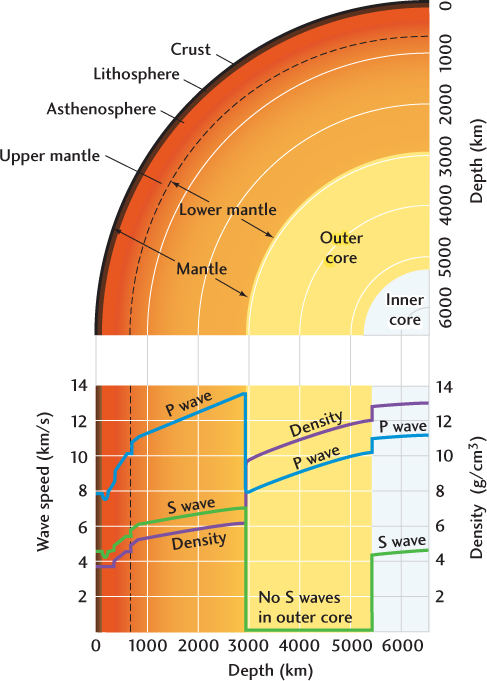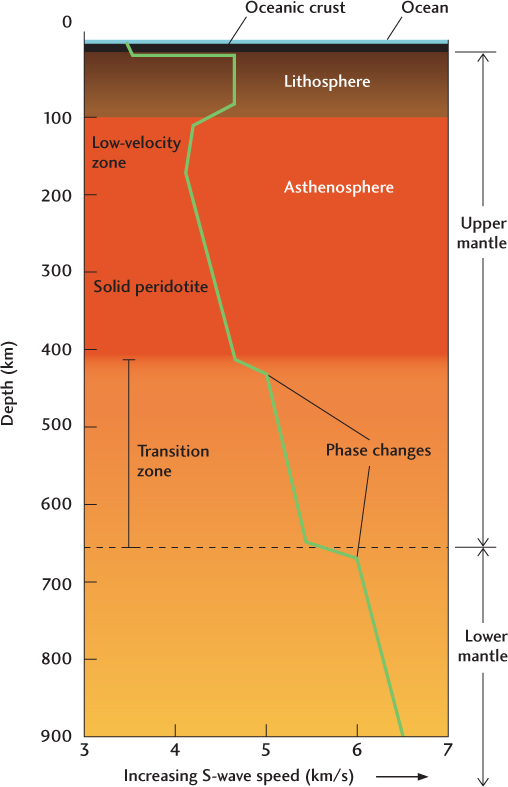Layering and Composition of Earth’s Interior
By measuring the travel times of compressional and shear waves from earthquakes around the world, geologists have developed a detailed model of how the wave speeds change with depth from Earth’s surface to its center. We will explore this Earth model, which is shown in Figure 14.7, by taking an imaginary downward journey through Earth’s interior, from its outer crust to its inner core.

The Crust
By measuring the velocities of seismic waves passing through samples of various materials in the laboratory, seismologists have compiled a library of seismic wave velocities through different rock types. Rough values for P-wave velocities in igneous rocks, for example, are as follows:
 Felsic rocks typical of the upper continental crust (granite): 6 km/s
Felsic rocks typical of the upper continental crust (granite): 6 km/s Mafic rocks typical of oceanic crust or the lower continental crust (gabbro): 7 km/s
Mafic rocks typical of oceanic crust or the lower continental crust (gabbro): 7 km/s Ultramafic rocks typical of the upper mantle (peridotite): 8 km/s
Ultramafic rocks typical of the upper mantle (peridotite): 8 km/s
These velocities vary because they depend on a rock’s density and its resistance to compression and shear, which depend on chemical composition and crystal structure. In general, higher densities correspond to higher P-wave velocities; typical densities for granite, gabbro, and peridotite are 2.6 g/cm3, 2.9 g/cm3, and 3.3 g/cm3, respectively.
We know from measurements of P-wave velocities that the upper part of the continental crust is made mostly of low-density granitic rocks. The measurements also show that no granite exists on the deep seafloor; the crust there consists entirely of basalt and gabbro overlain by sediments. The velocity of P waves increases abruptly to 8 km/s at the Mohorovičić discontinuity, or Moho, which marks the base of the crust (see Chapter 1). That velocity indicates that the mantle below the Moho is made primarily of dense peridotite.
Seismic data show that Earth’s crust is thin (about 7 km) under the oceans, thicker (about 33 km) under the stable, flat-lying continents, and thickest (as much as 70 km) under the high mountains of orogenic zones. The elevations of continents relative to the deep seafloor can be explained by the principle of isostasy, which states that the total weight of lithospheric columns should be same for continents and oceans (see the Practicing Geology exercise at the end of the chapter).
The Mantle
The upper mantle, which extends from the Moho to 410 km, is made primarily of peridotite, a dense ultramafic rock composed primarily of olivine and pyroxene. These minerals contain less silica and more magnesium and iron than those in typical crustal rocks (see Chapter 4). S-wave velocities have been used to explore the layering of the mantle (Figure 14.8). The layering of the upper mantle is caused primarily by the effects of increasing temperature and pressure on peridotite. Olivine and pyroxene undergo partial melting under the conditions found in the uppermost part of the mantle. At greater depths, increasing pressure forces the atoms of these minerals closer together into more compact crystal structures.

The mantle just below the Moho is relatively cold. Like the crust, it is part of the lithosphere, the rigid layer that forms the plates (see Chapter 1). On average, the thickness of the lithosphere is about 100 km, but it is highly variable geographically, ranging from almost no thickness near spreading centers, where new oceanic lithosphere is forming from hot, rising mantle material, to over 200 km beneath the cold, stable continental cratons.
389
Near the base of the lithosphere, S-wave velocity abruptly decreases, marking the start of a low-velocity zone. At about 100 km, the temperature approaches the melting temperature of peridotite, partially melting some of its minerals. Although the amount of melting is small (in most places, less than 1 percent), it is sufficient to decrease the rigidity of the rock, which slows the S waves passing through it. Because partial melting also allows the rock to flow more easily, geologists identify the low-velocity zone with the top part of the asthenosphere: the weak, ductile layer on which the rigid lithospheric plates slide. This idea fits nicely with evidence that the asthenosphere is the source of most basaltic magmas (see Chapters 4 and 12).
The base of the low-velocity zone lies at about 200 to 250 km below oceanic crust, where S-wave velocity increases to a value consistent with solid peridotite. The low-velocity zone is not as well defined under stable continental cratons, where colder lithospheric mantle extends to these depths.
At depths of about 200 to 400 km, the S-wave velocity again increases with depth. Within this zone, pressure continues to increase with depth, but the temperature does not rise as rapidly as it does near the surface, due to the effects of convection within the asthenosphere. (We will discuss why this is so in the next section.) The combined effects of pressure and temperature decrease the amount of melting with depth and cause rock rigidity—and thus S-wave velocity—to rise.
About 400 km below the surface, S-wave velocity increases by about 10 percent within a narrow zone less than 20 km thick. This jump in S-wave velocity can be explained by a phase change in olivine, the major mineral constituent of the upper mantle, whose ordinary crystal structure is transformed into a denser, more closely packed structure at high pressures. When olivine is subjected to high pressures in the laboratory, the atoms that form its crystal structure shift into a more compact arrangement at the temperatures and pressures corresponding to depths of about 410 km. Moreover, the jumps in the P- and S-wave velocities measured in the laboratory match the increase observed for seismic waves at this depth.
Below 410 km, mantle properties change slowly as depth increases, but at a depth of about 660 km, the S-wave velocity abruptly increases again, indicating a second major phase change in olivine to an even more closely packed crystal structure. Laboratory experiments have confirmed the existence of another major mineralogical phase change at the pressures and temperatures found at this depth.
Because it contains at least two major phase changes, the layer between 410 km and 670 km in depth is called the transition zone. Phase changes are transitions in a rock’s mineralogy, but not in its chemical composition. Some geologists have argued, however, that the increase in seismic wave velocities at 660 km comes in part from a change in the chemical composition of mantle rock. This debate was critical to understanding the plate tectonic system, because a chemical change would imply that the convection that drives plate tectonics does not penetrate much beyond this depth—in other words, that convection in the mantle is stratified (as shown in Figure 2.18b). Evidence from detailed studies of mantle structure now indicates very little, if any, chemical change in this region of the mantle.
Below the transition zone at 660 km, seismic wave velocities increase gradually and do not show any more unusual features until close to the core-mantle boundary. This relatively homogeneous region, more than 2000 km thick, is called the lower mantle. The lower mantle is convecting and exchanges mass with the upper mantle, driven in part by slabs of oceanic lithosphere subducting through the upper mantle into the lower mantle.
390
The Core-Mantle Boundary
At the core-mantle boundary, about 2890 km below the surface, we encounter the most extreme change in properties found anywhere in Earth’s interior. From the way seismic waves are reflected by this boundary, seismologists can tell that it is a very sharp interface. The material changes abruptly from solid silicate rock to a liquid iron alloy. Because of the complete loss of rigidity, the S-wave velocity drops from about 7.5 km/s to zero, and the P-wave velocity drops from more than 13 km/s to about 8 km/s, resulting in the core shadow zones. Density, on the other hand, increases by about 4 g/cm3 (see Figure 14.7). This large density difference, which is even greater than the increase in density from atmosphere to lithosphere at Earth’s solid surface, keeps the core-mantle boundary very flat (you could probably skateboard on it!) and prevents any large-scale mixing of the mantle and core.
The core-mantle boundary appears to be a very active place. Heat conducted out of the core increases the temperatures at the base of the mantle by as much as 10008C (see Figure 14.10). Indeed, the paths of seismic waves that pass near the base of the mantle show peculiar complications, suggesting a region of exceptional geologic activity. In a thin layer above the core-mantle boundary, there is a steep (10 percent or more) decrease in seismic wave velocities, which may be an indication that the mantle in contact with the core is partially molten, at least in some places. As we noted in Chapter 12, some geologists believe this hot region to be the source of mantle plumes that rise all the way to Earth’s surface, creating volcanic hot spots such as Hawaii and Yellowstone.
The lowest boundary layer of the mantle, a region about 300 km thick, may be the ultimate graveyard of some subducted lithospheric material, such as the dense, iron-rich parts of the oceanic crust. It is possible that this zone experiences an upside-down version of the tectonics we see at Earth’s surface. For example, accumulations of heavy, iron-rich material might form chemically distinct “anticontinents” that are constantly pushed to and fro across the core-mantle boundary by convection currents. We still have a lot to learn about the geologic processes that might be active in this strange place.
The Core
Many lines of evidence support the hypothesis that Earth’s core is made of iron and nickel. These metals are abundant in the universe (see Chapter 1); in addition, they are dense enough to explain the mass of the core (about one-third of Earth’s total mass) and to be consistent with the theory that the core formed by gravitational differentiation (see Chapter 9). This hypothesis, first proposed by Emil Wiechert in the late nineteenth century, was buttressed by discoveries of meteorites made almost entirely of iron and nickel, which presumably came from the breakup of a planetary body that also had an iron-nickel core (see Figure 1.10).
Laboratory measurements at appropriately high pressures and temperatures have led to a slight revision of this hypothesis. A pure iron-nickel alloy turns out to be about 10 percent too dense to match the data for the outer core. Therefore, it has been proposed that the core includes minor amounts of some lighter element. Oxygen and sulfur are leading candidates, although the precise composition remains the subject of research and debate.
Seismology tells us that the core below the mantle is liquid, but the core is not liquid to the very center of Earth. As Lehmann first discovered, P waves that penetrate to depths of 5150 km suddenly speed up, indicating the presence of an inner core, a metallic sphere two-thirds the size of the Moon. Seismologists have shown that the inner core transmits shear waves, confirming early speculations that it is solid. In fact, some calculations suggest that the inner core spins at a slightly faster rate than the mantle, acting like a “planet within a planet.”
The very center of the planet is not a place you would like to be. The pressures are immense, over 4 million times the atmospheric pressure at Earth’s surface. And it’s also very hot, as we are about to see.